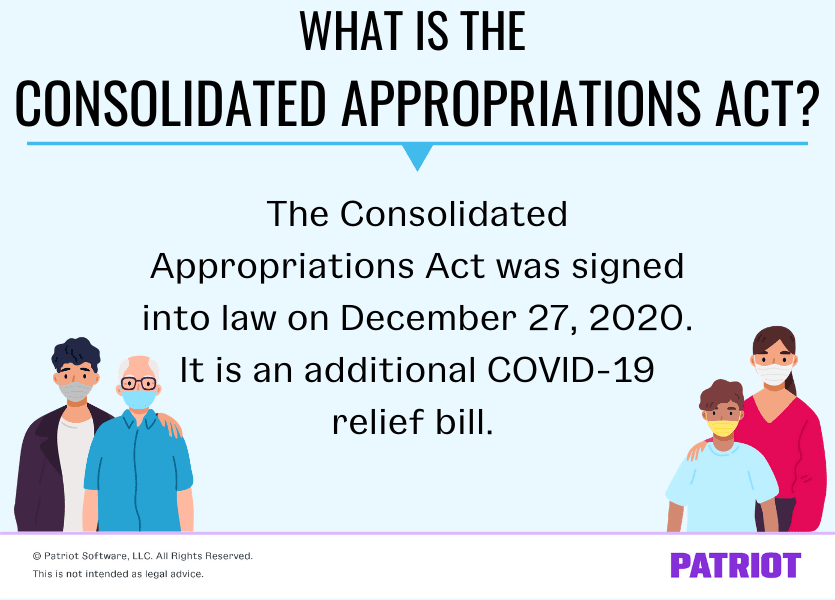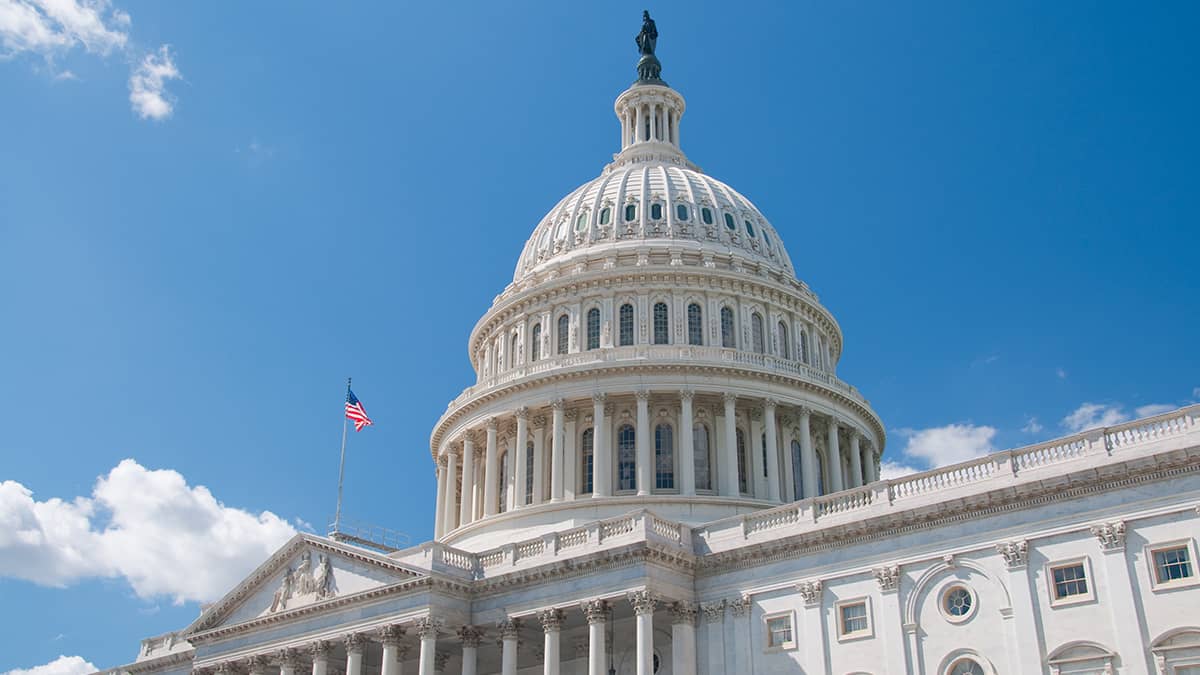Between a worldwide pandemic and numerous COVID-19 relief laws to keep up with, 2020 was a whirlwind of a year. And, it looks like the start of 2021 is following in 2020’s footsteps.
After a lot of back and forth, the president signed the Consolidated Appropriations Act 2021 (also called the CAA or the “Act”) into law on December 27, 2020. The COVID-19 legislation enhances and expands certain aspects of the CARES Act (Coronavirus Aid, Relief, and Economic Security Act).
Read on to learn all about what the coronavirus relief bill entails and how it may impact you, your employees, and your business.
Consolidated Appropriations Act
At this point, there are probably a ton of questions running through your head. How is this coronavirus relief bill going to affect my company? What changes will I have to make? If you’re frantically asking yourself these types of questions, don’t worry—you’re not alone.
Take a deep breath. If you’re looking for an easy-to-digest and understandable summary of the act, you’ve come to the right place.
Let’s take a look at what changes and updates are coming along with the Consolidated Appropriations Act, shall we?

Paycheck Protection Program
One of the biggest changes with the bill includes updates to the Paycheck Protection Program (PPP). The CAA renewed funding for the PPP for both first- and second-time loan borrowers.
If you’re a business owner, you’re likely familiar with the PPP. But just in case you need a refresher, here’s a brief rundown. The PPP was established under the CARES Act in March 2020. The PPP provides forgivable loans to small businesses to help cover payroll costs and non-payroll costs (e.g., utilities). The program incentivizes businesses to retain employees on payroll.
The PPP closed on August 8, 2020. But, the Consolidated Appropriations Act reopened the PPP through March 31, 2021. This means that business owners have until March 31 to apply for their first or second PPP loan.
So, what kind of changes did the CAA bring to the PPP? The bill:
- Expands PPP loan eligibility to small nonprofits, including 501(c)(6), destination marketing organizations (DMOs), and housing cooperatives that are first-time borrowers with 300 or fewer employees (as long as their lobbying activities do not exceed 15% of their lobbying activities and the cost of their lobbying activities does not exceed $1,000,000)
- Gives more flexibility by allowing borrowers to select their covered period (between 8 and 24 weeks)
- Allows businesses to take out a PPP loan and claim the Employee Retention Credit
- Provides a simplified application process for loans less than $150,000
- Allows for second-time PPP loan borrowers (first-time borrowers can also apply)
- Lets business owners use loans for additional expenses, including covered operations expenditures (e.g., business software), covered property damage (e.g., vandalism), supplier costs (e.g., items for operation), and worker protection expenditures (e.g., personal protective equipment)
Second-time PPP loan borrowers
As mentioned, the CAA allows certain businesses to apply for a second PPP loan (aka a “Second Draw” PPP loan). To be eligible for a second PPP loan, you must:
- Employ 300 or fewer employees
- Have used up your first PPP loan funds
- Demonstrate that your gross receipts in any 2020 quarter are at least 25% less than the same 2019 quarter
- Not engage in political or lobbying activities, describe yourself as a think tank, or be affiliated with businesses in China
- Not receive a Shuttered Venue Operator Grant
Second-time applicants can receive PPP loans up to $2 million. On the other hand, a first-time applicant can receive up to $10 million in PPP funds.
For more information about the PPP, if you’re qualified for a loan, and how to apply, read our article, “Paycheck Protection Program: How to Apply for a Forgivable Loan During COVID-19.”
Economic Injury Disaster Loan program
The bill also provides additional funding for the Economic Injury Disaster Loan Program (EIDL). The EIDL is one of the coronavirus loans through the Small Business Administration (SBA). The EIDL program was made to help small businesses affected by a declared disaster (e.g., coronavirus).
The EIDL program ran out of funds in July 2020. But, the Consolidated Appropriations Act will replenish funds by providing $20 billion for EIDL grants. These grants will be available for small businesses and nonprofits in low-income communities that had a 30% economic loss and have less than 300 employees.
The additional funding also permits small businesses in low-income communities that received an EIDL advance to receive additional funds (up to $10,000).
The bill also extends the covered period for emergency EIDL grants through December 31, 2021. You have until December 31, 2021 to apply.
Keep in mind that the EIDL program could potentially run out of funds before the December 31 application deadline. If your business qualifies, be sure to apply for a loan as soon as possible.
For more information about the EIDL program and updates, check out the SBA’s website.
Employee Retention Tax Credit
The recently passed bill also extends and expands the CARES Act’s Employee Retention Tax Credit (ERTC or ERC). The ERC is a fully refundable tax credit that eligible employers who are able to keep employees on payroll can claim.
The bill makes a number of changes to the ERC. The bill:
- Extends the credit through June 30, 2021
- Increases the refundable payroll tax credit from a maximum of $5,000 to a maximum of $7,000 by changing the calculation from 50% of wages paid up to $10,000 to 70% of wages paid up to $10,000 per quarter
- Expands eligibility by reducing the required year-over-year gross receipts decline from 50% to 20%
- Provides a safe harbor allowing employers to use previous quarter gross receipts to determine eligibility
- Increases the limit on per-employee creditable wages from $10,000 for the year to $10,000 each quarter
- Removes the 30-day wage limitation
- Allows businesses with 500 or fewer employees to advance the credit anytime during the quarter based on wages paid in the same quarter in a previous year
- Allows new employers (including employers that did not exist for all or part of 2019) to be eligible for the credit
In addition to the above, the Act also clarifies:
- The determination of gross receipts for tax-exempt organizations
- That group health plan expenses can be considered qualified wages even when the employee receives no other wages
- That employers who receive a PPP loan can qualify for the ERTC
One major change to keep in mind is that businesses can now take the Employee Retention Tax Credit and participate in the PPP. Before, businesses were only allowed one or the other.
Paid sick and family leave tax credits
The Families First Coronavirus Response Act (FFCRA) provided many relief measures, including coronavirus-related paid sick time and paid family and medical leave. The FFCRA required that employers with fewer than 500 employees provide eligible employees with paid sick and paid family and medical leave.
The FFCRA mandatory paid leave programs expired December 31, 2020. But, employers can opt to extend the paid leave program for employees through March 31, 2021.
If you voluntarily extend the paid leave program, you can continue to claim the payroll tax credit under the same rules. Keep in mind that employers are not required to provide FFCRA leave between January 1, 2021 – March 31, 2021. But if you opt to offer paid leave, you are eligible for the tax credits for wages paid.
Employers who voluntarily choose to continue providing coronavirus paid leave benefits can collect corresponding tax credits up to the cap (e.g., 80 hours for FFCRA sick leave). If an employee already took 80 hours of paid sick leave for a qualifying reason in 2020 and the employer claimed the tax credit in 2020 for that leave, the employer cannot claim an additional tax credit on wages paid to that same employee for additional paid sick leave benefits in 2021.
In short, the act extends employer tax credits for paid sick leave and expands family and medical leave (voluntary) for employees until March 31, 2021. Again, employers are no longer legally required to provide paid leave under the FFCRA.
Employer Social Security payroll tax credits
To offset paid sick and family leave related to COVID-19 under the FFCRA, the bill also includes an extension of the employer Social Security payroll tax credits. This is also extended through March 31, 2021.
Employee Social Security tax deferral
In August 2020, executive orders were issued allowing employers to defer payment of the employee portion of Social Security taxes.
Originally, employers were required to withhold and pay the deferred employees’ SS taxes between January 1, 2021 – April 30, 2021. Thanks to the CAA, the repayment period has been extended to December 31, 2021.
The act does not change the period for deferring employee SS tax. The employee Social Security tax deferral period was September 1, 2020 – December 31, 2020.
With the extension of the repayment period, you must pay back the deferred employee Social Security taxes by December 31, 2021 instead of April 30, 2021.
Stimulus checks
Another relief measure in the Act is a second round of stimulus checks. As a brief refresher, a stimulus check, also known as a recovery rebate or economic impact payment, is money sent to qualifying individuals to help stimulate the economy and provide financial assistance during trying times (e.g., coronavirus).
The first round of stimulus checks was $1,200 per qualifying individual. The amount an individual receives depends on their adjusted gross income (AGI).
This time around, the stimulus checks are $600 per person, or $1,200 per married couple. Children under 17 years old will also receive $600 each. And, there is no cap on household size. However, children who are 17 or older are ineligible, including adult dependents (e.g., college students).
The IRS will use 2019 tax returns to determine an individual’s stimulus payment. The same AGI thresholds apply to the second round of stimulus checks. Individuals will receive the full $600 if their adjusted gross income is less than:
- $75,000 (individuals)
- $112,500 (head of household)
- $150,000 (married)
Like the last round of stimulus checks, individuals can receive a reduced amount, depending on adjusted gross income. The stimulus amount decreases for people earning above the set thresholds. Single individuals with no qualifying dependents who earn over $87,000 and married couples with no qualifying dependents with earnings over $174,000 will not be eligible for the second round of payments.
In addition to the stimulus amount decreasing and some threshold adjustments, families with members of mixed immigration status with a valid Social Security number for one spouse are also eligible for a stimulus payment.
Unemployment insurance compensation benefits
The CAA also brings some new changes to unemployment insurance compensation benefits. Unemployment benefits help workers who are unemployed through no fault of their own.
Under the coronavirus legislation, the Pandemic Unemployment Assistance (PUA) program was increased by 11 weeks. Because of the extension, the PUA program will now continue through March 14, 2021. Like the PUA under previous COVID-19 legislation, the program extends to the self-employed, gig workers, and others in non-traditional employment.
The Act also reinstated the Pandemic Unemployment Compensation program (expired in July) to provide supplemental payments of $300 per week to any individual eligible for state unemployment benefits.
The CAA also extends the Pandemic Emergency Unemployment Compensation (PEUC) program through March 14, 2021. This extension will provide additional weeks of federally funded unemployment benefits to individuals who exhaust their regular state benefits.
Consolidated Appropriations Act: Fast facts for skimmers
It’s no secret that the legislation can be a lot to keep up with and grasp. To simplify the act for you, here’s a handy dandy breakdown of the key points from above:
- Paycheck Protection Program
- Reopened through March 31, 2021
- Both first- and second-time loan borrowers can apply
- Expanded PPP loan eligibility to small nonprofits, destination marketing organizations (DMOs), and housing cooperatives with 300 or fewer employees
- Borrowers to select their covered period (between 8 and 24 weeks)
- Businesses to take out a PPP loan and claim the Employee Retention Credit
- Simplified application process for loans less than $150,000
- Businesses can use loans for additional expenses, including covered operations expenditures, covered property damage, supplier costs, and worker protection expenditures
- Economic Injury Disaster Loan program
- CAA offers $20 billion for new EIDL grants
- Grants available for businesses in low-income communities that had a 30% economic loss and have fewer than 300 employees
- Small businesses in low-income communities that received an EIDL advance can receive additional funds up to $10,000
- Covered period extended for emergency EIDL grants through December 31, 2021
- Employee Retention Tax Credit
- Extended through June 30, 2021
- Refundable payroll tax credit increased from a maximum of $5,000 to a maximum of $14,000 by changing the calculation from 50% of wages paid up to $10,000 to 70% of wages paid up to $10,000 per quarter
- Expanded eligibility
- Limit on per-employee creditable wages increased from $10,000 for the year to $10,000 each quarter
- Businesses with 500 or fewer employees can advance the credit anytime during the quarter based on wages paid in the same quarter in a previous year
- New employers (including employers that did not exist for all or part of 2019) can be eligible for the credit
- Business owners can claim the ERTC and take out a PPP loan
- Paid sick and family leave tax credits
- Paid sick and family leave under the FFCRA is no longer mandatory as of January 1, 2021
- Employers can opt to extend the paid leave program for employees through March 31, 2021
- Employers who voluntarily choose to continue providing coronavirus paid leave benefits can collect corresponding tax credits up to the cap (e.g., 80 hours for FFCRA sick leave)
- Employee Social Security tax deferral
- The repayment period has been extended to December 31, 2021
- Employers must pay back deferred employee Social Security taxes by December 31, 2020 instead of April 30, 2021
- Stimulus checks
- $600 per individual, or $1,200 per married couple
- $600 for each child under the age of 17
- No cap on household size
- Adult dependents are not eligible
- Families with members of mixed immigration status with a valid
- Social Security number for one spouse are eligible for a stimulus payment
- Unemployment insurance compensation benefits
- PUA program increased by 11 weeks and will now continue through March 14, 2021
- The Pandemic Unemployment Compensation program has been reinstated to provide supplemental payments of $300 per week to any individual eligible for state unemployment benefits
- The Pandemic Emergency Unemployment Compensation (PEUC) program has been extended through March 14, 2021
This is not intended as legal advice; for more information, please click here.



